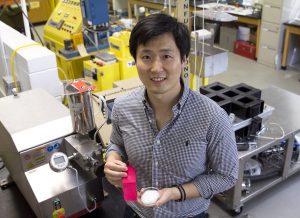Sustainable dyeing technology gives UGA win at international chemistry challenge
 A team of scientists from the University of Georgia College of Family and Consumer Sciences has won first prize in the inaugural Green and Sustainable Chemistry Challenge for an innovative and environmentally friendly textile dyeing technology using nanocellulosic fibers.
A team of scientists from the University of Georgia College of Family and Consumer Sciences has won first prize in the inaugural Green and Sustainable Chemistry Challenge for an innovative and environmentally friendly textile dyeing technology using nanocellulosic fibers.
Conventional dyeing processes require large amounts of water and create toxic effluent, or waste, that can be costly to treat. The wastewater from dye facilities often contains synthetic dyes and toxic chemicals, which leaves substantial ecological footprints, said research associate Yunsang Kim.
“The problem is that most of these textile dyeing industries are located in developing countries in which the regulation and societal concerns for environmental issues are really loose compared to developed countries,” Kim said.
The team’s project involves the production of nano-structured cellulose and the use of nanocellulose in a sustainable dyeing process that significantly reduces the amount of wastewater and toxic chemicals.
The competition, sponsored by Germany’s Leuphana University and Elsevier, a leading publisher of scientific and academic journals, promotes projects that best offer sustainable processes, products and resources suitable for use in developing countries. Nearly 500 proposals were submitted for the competition, with five selected as finalists after an extensive review process.
Kim presented the project on behalf of the UGA team at the Green and Sustainable Chemistry Conference in Berlin this month.
“It was amazing,” Kim said of hearing the announcement. “We now have an opportunity to develop our project to the next stage in which we will be able to contribute to helping people in developing countries.”
The team’s process involves using cellulose to dye materials. During a homogenization process, cellulose, a readily available natural polymer found in the primary cell wall of green plants, is converted into a hydrogel material consisting of nanocellulose fibers.
Compared to cotton fibers, nanocellulose fibers have 70 times more surface area with high reactivity, allowing for the efficient uptake and attachment of dye molecules.
Dyed nanocellulose hydrogels are then transferred to a textile by a conventional printing method.
“We were able to reduce the amount of water and dye auxiliaries such as inorganic salt and alkali by a factor of 10,” Kim said. “We are also working on the incorporation of other functionalities onto textiles using nanocellulose as a vehicle, capitalizing on its extremely large surface area and strong affinity to cotton-based textiles.”
College faculty members who participated in the project are Suraj Sharma, associate professor in the textiles, merchandising and interiors department; Sergiy Minko, the Georgia Power Professor of Polymers, Fibers and Textiles; and Ian Hardin, the Georgia Power Professor of Textile Science Emeritus.
The project is part of the recently announced Advanced Functional Fabrics of America Institute, a national public-private consortium established to revolutionize the fabric and textiles industry through commercialization of highly functional, advanced fibers and textiles for the defense and commercial markets.
